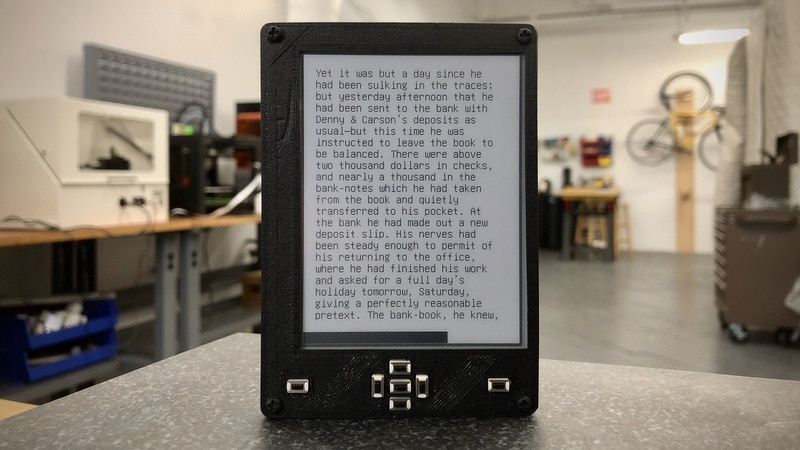I hope I’ve cross-posted this the right way haha. What do you think of this project?
It’s really cool. Information should be as cheap to access as possible and the platforms for doing so should be available to all.
I will say that there are two factors I look for in a reading experience that might need improving here.
The first is ergonomics. If I’m going to be holding an object for about two hours a day, every day, then it needs to feel good in my hand. This model looks a little chunky and unfinished. As a proto-type that’s fine, but whilst you shouldn’t judge a book by it’s cover, it helps if that cover isn’t made out of sand paper.
The second is the font. That’s the bit that gets the text from the page to your eyes. Typesetters and typemakers have spent an awfully long time figuring out what fonts work well for reading, and I don’t think the font being used here is one of them. Also, folk have different requirements for fonts. Can that be changed by the user?
There’s also the issue of format. Right now it appears to only support plain text files which is odd because isn’t epub an open format and a pretty good standard?
That’s fantastic. I loved my ereader (amazon) but I couldn’t shake the feeling that I was giving away my data and every purchase wasn’t really a purchase. I mean I tried to export my books but it wasn’t possible.
You can export your Amazon library at the current moment, as long as the books aren’t published (or maybe purchased?) after 2023.
I did this for a friend recently and my steps were:
- Started a Windows VM (if you’re not using Windows)
- Install Kindle for PC app, latest version
- Log in and download every book (I didn’t know how to do this in bulk so I literally right click -> downloaded every book)
- Install Calibre on the same PC (I think this is necessary so it can access the Kindle encryption keys?)
- Install a plugin by navigating to Preferences -> Plugins -> Get new plugins: KFX Input plugin
- Install a plugin by navigating to Preferences -> Plugins -> Load plugin from file, using DeDRM 10.0.9’s “DeDRM_tools_10.0.9.zip”
- Restart Calibre
- At the top of Calibre, right click “Add books” and pick “Add from folder and sub-folders”
- Navigate to your documents and pick “My Kindle Content”, then select “Yes” to “All ebook files are multiple formats etc”
- Wait for it all to import
- Select all books, then right click “Remove books” at the top and pick “Remove files of a specific format from selected books”
- Pick “MD” and click “OK”
- With all books selected, click “Edit metadata” at the top
- Pick “Set metadata (except cover) from the e-book files”, then click OK
- Done, sort of. The DRM should all be broken, and you can convert the books to EPUB or whatever format using Calibre from this point forward, even if Amazon breaks this method in the future.
😮❤️👌
You can buy books elsewhere without DRM and copy them to the kindle via cable. You can even buy protected books from the Amazon shop and download them for offline installation. If the device never connects to the web, they can’t delete anything remotely.
Mine has been offline ever since I bought it, 8 years ago.
I think there are two major roadblocks to adoption of any (not just FOSS) third-party ebook reader in this day and age: one is how to acquire ebooks legally and the other is how to get these books onto the device afterwards. While imperfect, the Kindle does integrate with a user’s Amazon account and provide a fairly simple mechanism for an individual to sync their purchased ebooks with their physical device. For most other devices, you’re probably going to have to actually attach the device to a PC and copy files to internal storage or pop out the SD card and use that. For your moderately competent user, that’s great, but to some extent we’re living in a progressively more and more tech illiterate society where both younger and older Americans have never had to do something like this. I think a good business idea for someone would be to create a non-Amazon ebook store with a focus on creating clients for different ebook readers, assuming those readers supported third party apps, that would provide a similarly easy mechanism of purchasing and downloading ebooks.






